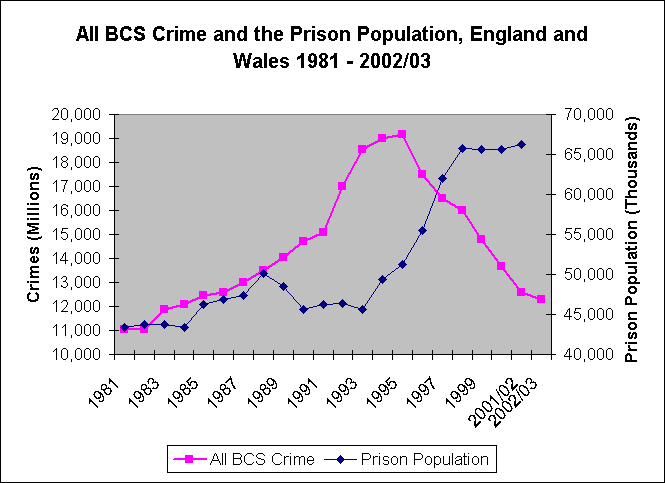Crime is falling crime because prison works David Green
Click here for the original Observer piece.
According to the latest British Crime Survey (BCS) overall crime has continued to fall over the last year. Why? And what does it tell us about Mr Blunkett’s policies? The main lesson is an uncomfortable one for people of a liberal disposition who instinctively prefer to see offenders rehabilitated rather than incarcerated.
Crime has fallen chiefly because more offenders are in prison. In the 12 months up to December 2002 alone the prison population increased by 3,563 to 69,612. This week it is 74,000. Yet, the government has embarked on a policy of replacing prison with ‘intensive supervision’ in the community, a strategy that has already been tried in other countries, where it was found to make little difference to re-offending.
To claim that increasing the use of prison reduces crime is controversial. What is the evidence? Despite misleading rhetoric about short-sharp shocks, during the 1980s the Tory Government pursued an anti-prison policy and between 1988 and 1993 the prison population was cut by nearly 10 per cent. The crime rate reached an historic peak soon after and towards the end of 1993 the policy was reversed by Home Secretary, Michael Howard. Between 1993 and 2001 the average number of people in prison rose from 45,633 to 66,300, an increase of over 45%.
What happened to crime over this period? According to the BCS crime fell from 19.1 million in 1995 to 12.6 million in 2001/02. Was it just a coincidence? Armies of academics argue the toss, but no one disputes that, while in jail offenders cannot break into your house, whereas when on a community sentence they still have the free time to steal. Criminologists call this the ‘incapacitation’ effect.
Even if no deterrent effect is assumed, the incapacitation effect of imprisoning on average another 20,000 criminals would have been substantial. How can we work out the incapacitation effect? The Home Office report, Making Punishments Work, estimated that the average offender carried out 140 offences per year. The variation was large, and offenders who admitted a drug problem, were committing an average of 257 offences per year.
We can make a rough calculation of the incapacitation effect of jailing 20,000 full-year equivalent offenders. If each prisoner carried out the average number of offences identified by the Home Office, then 2.8 million offences against the public would have been prevented by 12 months in jail. If they were high-rate offenders, the effect would have been 5.1 million offences. This would account for a large chunk of the fall from 19 million crimes to 12 million.
Labour home secretaries know this and have continued Michael Howard’s policies, though reluctantly. Between 1997 and July 2003 the prison population increased by 12,000. What was the incapacitation effect of jailing these offenders? If they carried out the average number of offences, then there would have been 1.7 million fewer victims of crime. And in the last year alone, the additional 3,500 prisoners would have accounted for nearly half a million fewer crimes.
How much did crime actually fall? Since 1997, according to the BCS, there have been 4 million fewer crimes per year. And in the last year, crime fell by about 250,000 offences to 12.3 million in 2002/03.
The Government is under intense pressure to improve public services and, as both Mr Blair and Mr Blunkett secretly realise, being ‘tough on crime’ is a lot more effective in the short run than being tough on the causes of crime. They also know that, if the Government is to keep crime falling, it will need to build more prisons. Yet the policy set out in last year’s white paper, Justice for All, is to replace prison with intensive supervision and surveillance in the community. However intensive it might be, it is no substitute for the almost total public protection afforded by prison. Perhaps that is why the Home Office is projecting an increase in prison places of between 91,000 and 109,000 by 2009.

